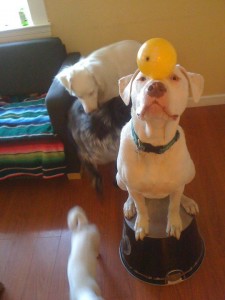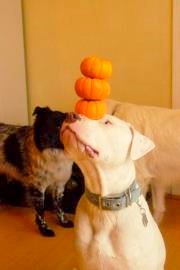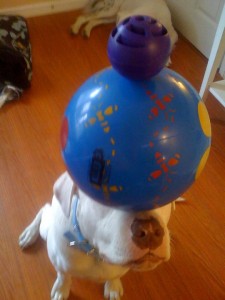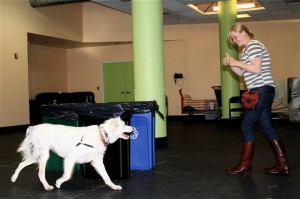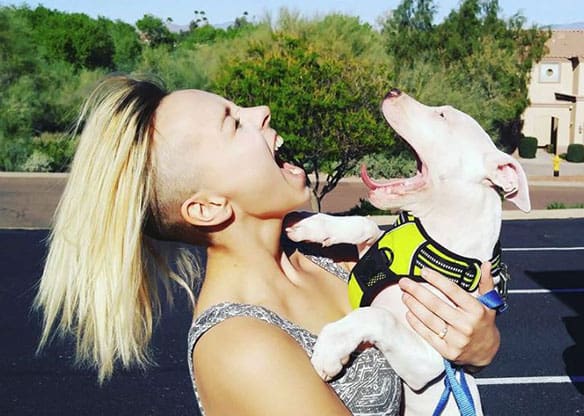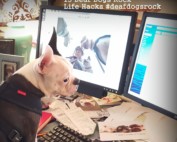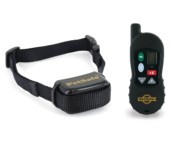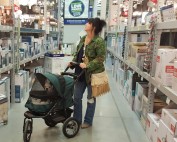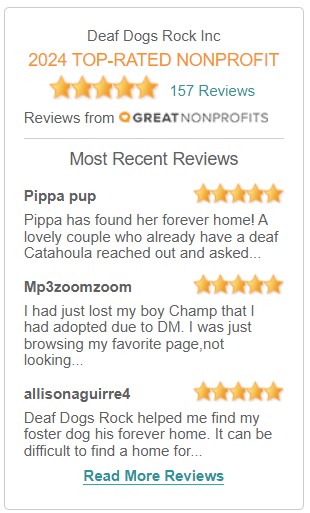Post from: 8/25/2013 – From Reed Morgan.
I’m on the board of Northern Calif. Family Dog Rescue, and had fostered many dogs before Argus. One morning I volunteered to help take some dogs in to their spay/neuter appointments and my friend brought along a scrawny, beautiful, bright white Australian Shepherd with blue eyes and a pink nose. She knew I would fall in love with him because I have a soft spot for herding dogs, Aussies in particular. I offered to take him in for his appointment and while we waited in the cold for the vet to open, he sat with his whole body pressed against my legs and looked into my eyes. There was something so magical about him that I first named him Prince after Saint-Exupéry’s Little Prince. By the time the vet opened the door, I knew my friend was right.
The following weekend I picked him up from his foster home and took him to a mobile adoption; we walked a few blocks at a leisurely pace, as he wanted to walk the entire way with his body against mine. Also impeding our progress were several people who were as drawn to him as I was; the second I told them–and, once we made our way, potential adopters– that he was deaf and visually impaired, they would invariably would say “Oh Poor baby…” and quickly move on down the street or to the next dog. After I brought him home my boyfriend and I renamed him after Argus, the mythical Greek beast.
After voraciously researching deaf dog-specific training, and realizing that his sight was better than originally thought, I found I was able to use very broad hand signals to communicate with him. He took to training immediately; I barely needed to train him to focus on me at all, it seemed like he was born by my side. I still can’t leave the room without him following me, even if he’s in the deepest sleep.After a few days, I couldn’t imagine giving him to another home; after finding a much dog-friendlier apartment, we moved Argus across town and into our family.
Argus has only become easier to train, with basic, intermediate, and advanced SPCA classes already under his belt. After dabbling in Agility and K-9 Nosework, his current adventure is Triebball, a new sport where dogs herd giant exercise balls. He’s obsessed! Though he keeps me on my toes practice is rarely frustrating; the improvisation is super fun. Argus has grown to be my very best companion; I feel like I have such a strong connection with him that I barely have to look at him to convey what I’m thinking or what I want him to do. He’s grown from a scrawny twenty-six pounds to a big fluffy sixty and is as stuck on me as ever.
Argus dispelled many deaf-dog myths for me, and to date I’ve rescued/fostered 11 other deaf dogs ranging from Aussies, cattle dogs, frenchie mixes, a few pit bulls, and even one chihuahua. Family Dog has become known as one of the main rescues in Northern California for deaf dogs; even if I’m not fostering the dog I always meet with the adopter of a deaf dog to go over basic training. I think this personal touch is important, as I rarely could get face-to-face communication in my research. I try to keep in contact with the people who adopt my deaf fosters and encourage them to really work with their dogs past the point of just the basics.
Gator, the third deaf pit bull puppy we have fostered, came from a backyard breeder; 4 months old, chubby, lazy to the point of lethargy, and bratty, he could not have been more different than Argus. We renamed Gator after his first trip to the beach where my boyfriend pointed out how he walked like a fat alligator. I started putting him through deaf puppy boot camp because he came to us with a lot of bad habits, including demand barking, lack of boundaries, no basic command knowledge, destructo-mouth, and, of course, a pee-pee anywhere mentality . Unlike Argus he did not have a built in “watch me” so we spent a lot of time training him to focus on our facial expressions. I remember the moment when I caught him on our bed (where dogs are not allowed without permission) so I shot him an angry glance and it actually registered! Butt-head though he was, after that he learned basic commands super quickly and started having a blast training. He is taking a CGC class this summer and Rally in the fall.
He has a special talent for balancing items on his nose with two(!) balls as a personal best. He is the biggest clown we know and he constantly has us in tears laughing. Look him up on Facebook under”Gator The Deaf Circus Pittie”.
People often ask me how hard it is to live with a deaf dog, and I tellthem it’s not any harder than living with a dog that can hear, it’s just different. But once you learn the differences it’s so easy! I’ll close with one of my favorite stories about dogs and disabilities. While riding on BART we met a young guy who gave Gator the biggest smile. After talking about Gator for a minute it came up that Gator was deaf. The guy’s face lit up, and he pulled up his pant leg to show Gator his prosthetic leg! He was almost in tears; he had found a kindred spirit in Gator who shared the experience of people not realizing one’s disability and the condescension or fear that follows when the disability is revealed. More than anything, he said before we left the train, he just wanted to be treated the same as anyone else, and that’s how I think deaf or disabled dogs should be treated as well.
(Photo by Dianne Morey – Photo of Argus training with Reed Morgan)
This story was submitted by Reed Morgan. Thanks Reed for sharing your story of your amazing dog Argus with deafdogsrock!
Update: Gator has earned his Canine Good Citizen Award (CGC Award) and Argus in now taking Rally with a couple of other deaf dogs in their Rally class. Reed and her deaf dog friends in San Francisco have also started a new deaf dog club called the Bay Area Dog Club. Click here to view their Facebook Page. As soon as we get some new photos and info on Gator and his CGC award we will be adding him to our Deaf Dogs Rock CGC Wall of Fame.

